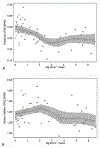[11C]dihydrotetrabenazine Positron Emission Tomography in Manganese-Exposed Workers
- PMID: 32472844
- PMCID: PMC7786890
- DOI: 10.1097/JOM.0000000000001915
[11C]dihydrotetrabenazine Positron Emission Tomography in Manganese-Exposed Workers
Abstract
Objective: To understand the neurotoxic effects of manganese (Mn) exposure on monoaminergic function, utilizing [C]dihydrotetrabenazine (DTBZ) positron emission tomography (PET) to measure vesicular monoamine transporter 2 (VMAT2).
Methods: Basal ganglia and thalamic DTBZ binding potentials (BPND) were calculated on 56 PETs from 41 Mn-exposed workers. Associations between cumulative Mn exposure, regional BPND, and parkinsonism were examined by mixed linear regression.
Results: Thalamic DTBZ BPND was inversely associated with exposure in workers with less than 3 mg Mn/m-yrs, but subsequently remained stable. Pallidal DTBZ binding increased in workers with less than 2 mg Mn/m-yrs of exposure, but decreased thereafter. Thalamic DTBZ binding was inversely associated with parkinsonism (P = 0.003).
Conclusion: Mn-dose-dependent associations with thalamic and pallidal DTBZ binding indicate direct effects on monoaminergic VMAT2. Thalamic DTBZ binding was also associated with parkinsonism, suggesting potential as an early biomarker of Mn neurotoxicity.
Conflict of interest statement
Criswell, Nielsen, Warden, Perlmutter, Moerlein, Sheppard, Lenox-Krug, Checkoway, and Racette have no relationships/conditions/circumstances that present potential conflict of interest.
The JOEM editorial board and planners have no financial interest related to this research.
Figures


Similar articles
-
A Novel Potential Positron Emission Tomography Imaging Agent for Vesicular Monoamine Transporter Type 2.PLoS One. 2016 Sep 9;11(9):e0161295. doi: 10.1371/journal.pone.0161295. eCollection 2016. PLoS One. 2016. PMID: 27612194 Free PMC article.
-
Selective D2 receptor PET in manganese-exposed workers.Neurology. 2018 Sep 11;91(11):e1022-e1030. doi: 10.1212/WNL.0000000000006163. Epub 2018 Aug 10. Neurology. 2018. PMID: 30097475 Free PMC article.
-
[18F]FDOPA positron emission tomography in manganese-exposed workers.Neurotoxicology. 2018 Jan;64:43-49. doi: 10.1016/j.neuro.2017.07.004. Epub 2017 Jul 8. Neurotoxicology. 2018. PMID: 28694016 Free PMC article.
-
Assessment of extrastriatal vesicular monoamine transporter binding site density using stereoisomers of [11C]dihydrotetrabenazine.J Cereb Blood Flow Metab. 1999 Dec;19(12):1376-84. doi: 10.1097/00004647-199912000-00011. J Cereb Blood Flow Metab. 1999. PMID: 10598942
-
Manganism in the 21st century: the Hanninen lecture.Neurotoxicology. 2014 Dec;45:201-7. doi: 10.1016/j.neuro.2013.09.007. Epub 2013 Oct 19. Neurotoxicology. 2014. PMID: 24148923 Free PMC article. Review.
Cited by
-
Depression and anxiety in a manganese-exposed community.Neurotoxicology. 2021 Jul;85:222-233. doi: 10.1016/j.neuro.2021.05.017. Epub 2021 Jun 2. Neurotoxicology. 2021. PMID: 34087333 Free PMC article.
-
Severity of parkinsonism associated with environmental manganese exposure.Environ Health. 2021 Mar 15;20(1):27. doi: 10.1186/s12940-021-00712-3. Environ Health. 2021. PMID: 33722243 Free PMC article.
-
Update: Protective and risk factors for Parkinson disease.Parkinsonism Relat Disord. 2024 Aug;125:107026. doi: 10.1016/j.parkreldis.2024.107026. Epub 2024 Jun 13. Parkinsonism Relat Disord. 2024. PMID: 38879999 Free PMC article. Review.
References
-
- Parmalee NL, Aschner M. Manganese and aging. Neurotoxicology. 2016;56:262–268. - PubMed
-
- Kim Y, Kim JM, Kim JW, et al. Dopamine transporter density is decreased in parkinsonian patients with a history of manganese exposure: what does it mean? Mov Disord. 2002;17:568–575. - PubMed
-
- Sikk K, Taba P, Haldre S, et al. Clinical, neuroimaging and neurophysiological features in addicts with manganese-ephedrone exposure. Acta Neurol Scand. 2010;121:237–243. - PubMed
Publication types
MeSH terms
Substances
Grants and funding
LinkOut - more resources
Full Text Sources
Medical

